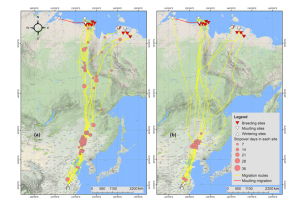Migration theory suggests, and some empirical studies show, that in order to compete for the best breeding sites and increase reproductive success, long-distance avian migrants tend to adopt a time minimization strategy during spring migration, resulting in shorter duration spring migration compared to that in autumn. Using GPS/GSM transmitters, we tracked the full migrations of 11 Greater White-fronted Geese (Anser albifrons) between southeast China and the Russian Arctic, to reveal the migration timing and routes of the East Asian population, and compare the difference in duration between spring and autumn migration of this population. We found that migration in spring (79?±?12 days) took more than twice as long to cover the same distance as in autumn (35?±?7 days). This difference in migration duration was mainly determined by significantly more time spent in spring (59?±?16 days) than in autumn (23?±?6 days) at significantly more stopover sites. We suggest that these geese, thought to be partial capital breeders, spent almost three quarters of total migration time at spring stopover sites to acquire energy stores for ultimate investment in reproduction, although we cannot reject the hypothesis that timing of the spring thaw also contributed to stopover duration. In autumn, they acquired necessary energy stores on the breeding grounds sufficient to reach Northeast China staging areas almost without stop, which reduced stopover times in autumn and resulted in the faster autumn migration than spring.






